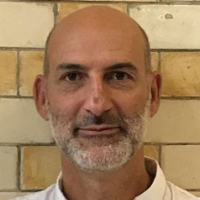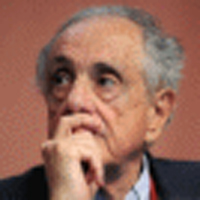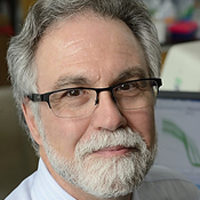




 Matteo Carandini, after graduating in Rome and earning his PhD in Neurological Sciences from New York University, worked at various US and European universities. He is the GlaxoSmithKline/Fight for Sight professor at University College London. Carandini conducts his research with the aim of contributing to the knowledge of how the brain processes visual information in the human brain, thus he studied the lateral geniculate nucleus, the primary visual cortex, the activity of individual neurons and the communications between them with the primary visual cortex, with a particular interest in the function of the eye, the thalamus and the primary visual area. Since 2017 he heads the International Brain Lab, the largest virtual brain laboratory, which unites 21 research centres between Europe and the United States. In this Lab a single researcher succeeded in recording activity from 30.000 neurones during a decision-making task. Next achievement is to monitor with Neuropixels technology the overall activity of 1 million neurons. The title of his talk is: “Recording from a myriad neurons”.
Matteo Carandini, after graduating in Rome and earning his PhD in Neurological Sciences from New York University, worked at various US and European universities. He is the GlaxoSmithKline/Fight for Sight professor at University College London. Carandini conducts his research with the aim of contributing to the knowledge of how the brain processes visual information in the human brain, thus he studied the lateral geniculate nucleus, the primary visual cortex, the activity of individual neurons and the communications between them with the primary visual cortex, with a particular interest in the function of the eye, the thalamus and the primary visual area. Since 2017 he heads the International Brain Lab, the largest virtual brain laboratory, which unites 21 research centres between Europe and the United States. In this Lab a single researcher succeeded in recording activity from 30.000 neurones during a decision-making task. Next achievement is to monitor with Neuropixels technology the overall activity of 1 million neurons. The title of his talk is: “Recording from a myriad neurons”.

 Marco Linari is full professor at the Faculty of Sciences of the University of Florence. Linari has been research fellow at University College London, member of the Operative Group in Grenoble for the application of diffraction X-ray to the study of muscle contraction and collaborative user for the development of structural studies on muscle with X-ray diffraction at Advanced Photon Source, Argonne,USA. The scientific activity of Prof Marco Linari concerns the study of the molecular mechanism of muscle contraction, through an integrated approach that involves the combination of techniques of mechanics, biochemistry, calorimetry and X-ray diffraction with synchrotron light on individual muscle fibers. The research activity resulted in numerous full-length publications in international journals. He has organized conferences, has been a speaker at exclusive international symposia (such as the Gordon Research Conference, 1999 and 2005) and has participated in several national and international research projects. The title of his talk is: "The role of thick filament mechanosensing in the Starling law of the heart".
Marco Linari is full professor at the Faculty of Sciences of the University of Florence. Linari has been research fellow at University College London, member of the Operative Group in Grenoble for the application of diffraction X-ray to the study of muscle contraction and collaborative user for the development of structural studies on muscle with X-ray diffraction at Advanced Photon Source, Argonne,USA. The scientific activity of Prof Marco Linari concerns the study of the molecular mechanism of muscle contraction, through an integrated approach that involves the combination of techniques of mechanics, biochemistry, calorimetry and X-ray diffraction with synchrotron light on individual muscle fibers. The research activity resulted in numerous full-length publications in international journals. He has organized conferences, has been a speaker at exclusive international symposia (such as the Gordon Research Conference, 1999 and 2005) and has participated in several national and international research projects. The title of his talk is: "The role of thick filament mechanosensing in the Starling law of the heart".

 José López-Barneo (MD, PhD) is Professor of Medical Physiology and Biophysics at the University of Seville Medical School, Spain. In 2006, he was appointed Director of the Institute of Biomedicine of Seville (IBiS) at the University Hospital “Virgen del Rocío”. Dr. López-Barneo's main research interests are related to the study of the mechanisms of acute oxygen sensing in mammals, specifically by the carotid body and other peripheral chemoreceptors, as well as the cellular adaptations to hypoxia. He also works on the modulation by hypoxia of the peripheral and central neurogenic centres and the molecular bases of dopaminergic neuroprotection and neurodegeneration. He will talk about “Acute oxygen sensing and regulation of breathing”.
José López-Barneo (MD, PhD) is Professor of Medical Physiology and Biophysics at the University of Seville Medical School, Spain. In 2006, he was appointed Director of the Institute of Biomedicine of Seville (IBiS) at the University Hospital “Virgen del Rocío”. Dr. López-Barneo's main research interests are related to the study of the mechanisms of acute oxygen sensing in mammals, specifically by the carotid body and other peripheral chemoreceptors, as well as the cellular adaptations to hypoxia. He also works on the modulation by hypoxia of the peripheral and central neurogenic centres and the molecular bases of dopaminergic neuroprotection and neurodegeneration. He will talk about “Acute oxygen sensing and regulation of breathing”.

 Lamberto Maffei is Professor of Neurobiology at the Scuola Normale Superiore Pisa, Italy and Vice-President of the Accademia dei Lincei. He studied Medicine at the University of Pisa, graduating in 1961. He worked in Tübingen, Cambridge, Boston, Paris, Oxford and Davis. In his early work he investigated the function of the mammalian visual system, pioneering research into spatial frequency selectivity in primary visual cortex, neural adaptation to contrast and extra-receptive field influences on visual neurons. He later moved on to study development and plasticity of the mammalian cortex, with major findings on the recovery of function after crushing of the optic nerve, the role of spontaneous discharge in pre-natal development, the importance of neural growth factors for plasticity, and how an enriched visual environment can improve visual performance and overcome induced amblyopia. The title of his talk is: "Matrimonio tra arte e cervello; officiante il cervello".
Lamberto Maffei is Professor of Neurobiology at the Scuola Normale Superiore Pisa, Italy and Vice-President of the Accademia dei Lincei. He studied Medicine at the University of Pisa, graduating in 1961. He worked in Tübingen, Cambridge, Boston, Paris, Oxford and Davis. In his early work he investigated the function of the mammalian visual system, pioneering research into spatial frequency selectivity in primary visual cortex, neural adaptation to contrast and extra-receptive field influences on visual neurons. He later moved on to study development and plasticity of the mammalian cortex, with major findings on the recovery of function after crushing of the optic nerve, the role of spontaneous discharge in pre-natal development, the importance of neural growth factors for plasticity, and how an enriched visual environment can improve visual performance and overcome induced amblyopia. The title of his talk is: "Matrimonio tra arte e cervello; officiante il cervello".

 Gregg L. Semenza is professor of genetic medicine, pediatrics, radiation oncology, and molecular radiation sciences, biological chemistry, medicine, and oncology at the Johns Hopkins University School of Medicine. Moreover, he is the C. Michael Armstrong Professor and serves as the director of the vascular program at the Institute for Cell Engineering. Dr. Semenza has led the field in uncovering how cells adapt to changing oxygen levels. He is best known for his ground-breaking discovery of the HIF-1 (hypoxia-inducible factor 1) protein, which controls changes in gene expression in response to changes in oxygen availability. The discovery of HIF-1 has far-reaching implications for understanding and treating conditions, such as cancer and ischemic cardiovascular disease, in which hypoxia plays an important role in disease pathogenesis. His lab's research has been published in more than 400 research articles and book chapters, which have been cited more than 150,000 times. Dr. Semenza was recognized for this groundbreaking research in 2019, when he was awarded the Nobel Prize in Physiology or Medicine with William G. Kaelin, Jr., M.D. of the Dana-Farber Cancer Institute, and Peter J. Ratcliffe of Oxford University. He will speak about: “Hypoxia-Inducible Factors in Physiology and Medicine”.
Gregg L. Semenza is professor of genetic medicine, pediatrics, radiation oncology, and molecular radiation sciences, biological chemistry, medicine, and oncology at the Johns Hopkins University School of Medicine. Moreover, he is the C. Michael Armstrong Professor and serves as the director of the vascular program at the Institute for Cell Engineering. Dr. Semenza has led the field in uncovering how cells adapt to changing oxygen levels. He is best known for his ground-breaking discovery of the HIF-1 (hypoxia-inducible factor 1) protein, which controls changes in gene expression in response to changes in oxygen availability. The discovery of HIF-1 has far-reaching implications for understanding and treating conditions, such as cancer and ischemic cardiovascular disease, in which hypoxia plays an important role in disease pathogenesis. His lab's research has been published in more than 400 research articles and book chapters, which have been cited more than 150,000 times. Dr. Semenza was recognized for this groundbreaking research in 2019, when he was awarded the Nobel Prize in Physiology or Medicine with William G. Kaelin, Jr., M.D. of the Dana-Farber Cancer Institute, and Peter J. Ratcliffe of Oxford University. He will speak about: “Hypoxia-Inducible Factors in Physiology and Medicine”.